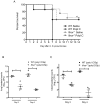Poly I:C enhances susceptibility to secondary pulmonary infections by gram-positive bacteria
- PMID: 22962579
- PMCID: PMC3433467
- DOI: 10.1371/journal.pone.0041879
Poly I:C enhances susceptibility to secondary pulmonary infections by gram-positive bacteria
Abstract
Secondary bacterial pneumonias are a frequent complication of influenza and other respiratory viral infections, but the mechanisms underlying viral-induced susceptibility to bacterial infections are poorly understood. In particular, it is unclear whether the host's response against the viral infection, independent of the injury caused by the virus, results in impairment of antibacterial host defense. Here, we sought to determine whether the induction of an "antiviral" immune state using various viral recognition receptor ligands was sufficient to result in decreased ability to combat common bacterial pathogens of the lung. Using a mouse model, animals were administered polyinosine-polycytidylic acid (poly I:C) or Toll-like 7 ligand (imiquimod or gardiquimod) intranasally, followed by intratracheal challenge with Streptococcus pneumoniae. We found that animals pre-exposed to poly I:C displayed impaired bacterial clearance and increased mortality. Poly I:C-exposed animals also had decreased ability to clear methicillin-resistant Staphylococcus aureus. Furthermore, we showed that activation of Toll-like receptor (TLR)3 and Retinoic acid inducible gene (RIG-I)/Cardif pathways, which recognize viral nucleic acids in the form of dsRNA, both contribute to poly I:C mediated impairment of bacterial clearance. Finally, we determined that poly I:C administration resulted in significant induction of type I interferons (IFNs), whereas the elimination of type I IFN signaling improved clearance and survival following secondary bacterial pneumonia. Collectively, these results indicate that in the lung, poly I:C administration is sufficient to impair pulmonary host defense against clinically important gram-positive bacterial pathogens, which appears to be mediated by type I IFNs.
Conflict of interest statement
Figures






Similar articles
-
Differential Type I Interferon Signaling Is a Master Regulator of Susceptibility to Postinfluenza Bacterial Superinfection.mBio. 2016 May 3;7(3):e00506-16. doi: 10.1128/mBio.00506-16. mBio. 2016. PMID: 27143388 Free PMC article.
-
Influenza-induced type I interferon enhances susceptibility to gram-negative and gram-positive bacterial pneumonia in mice.Am J Physiol Lung Cell Mol Physiol. 2015 Jul 15;309(2):L158-67. doi: 10.1152/ajplung.00338.2014. Epub 2015 May 22. Am J Physiol Lung Cell Mol Physiol. 2015. PMID: 26001778 Free PMC article.
-
Impact of Type I and III Interferons on Respiratory Superinfections Due to Multidrug-Resistant Pathogens.J Infect Dis. 2017 Feb 15;215(suppl_1):S58-S63. doi: 10.1093/infdis/jiw466. J Infect Dis. 2017. PMID: 28375519 Free PMC article.
-
The genetic basis of pneumococcal and staphylococcal infections: inborn errors of human TLR and IL-1R immunity.Hum Genet. 2020 Jun;139(6-7):981-991. doi: 10.1007/s00439-020-02111-z. Epub 2020 Jan 24. Hum Genet. 2020. PMID: 31980906 Free PMC article. Review.
-
Particulate formulations for the delivery of poly(I:C) as vaccine adjuvant.Adv Drug Deliv Rev. 2013 Oct;65(10):1386-99. doi: 10.1016/j.addr.2013.05.013. Epub 2013 Jun 7. Adv Drug Deliv Rev. 2013. PMID: 23751781 Review.
Cited by
-
Bacterial outer membrane vesicles bound to bacteriophages modulate neutrophil responses to bacterial infection.Front Cell Infect Microbiol. 2023 Oct 26;13:1250339. doi: 10.3389/fcimb.2023.1250339. eCollection 2023. Front Cell Infect Microbiol. 2023. PMID: 37965262 Free PMC article.
-
The administration of intranasal live attenuated influenza vaccine induces changes in the nasal microbiota and nasal epithelium gene expression profiles.Microbiome. 2015 Dec 15;3:74. doi: 10.1186/s40168-015-0133-2. Microbiome. 2015. PMID: 26667497 Free PMC article. Clinical Trial.
-
TLR7 promotes smoke-induced experimental lung damage through the activity of mast cell tryptase.Nat Commun. 2023 Nov 14;14(1):7349. doi: 10.1038/s41467-023-42913-z. Nat Commun. 2023. PMID: 37963864 Free PMC article.
-
Suppressing fatty acid synthase by type I interferon and chemical inhibitors as a broad spectrum anti-viral strategy against SARS-CoV-2.Acta Pharm Sin B. 2022 Apr;12(4):1624-1635. doi: 10.1016/j.apsb.2022.02.019. Epub 2022 Feb 28. Acta Pharm Sin B. 2022. PMID: 35251918 Free PMC article.
-
Differential Type I Interferon Signaling Is a Master Regulator of Susceptibility to Postinfluenza Bacterial Superinfection.mBio. 2016 May 3;7(3):e00506-16. doi: 10.1128/mBio.00506-16. mBio. 2016. PMID: 27143388 Free PMC article.
References
-
- Oliveira EC, Marik PE, Colice G (2001) Influenza pneumonia: a descriptive study. Chest 119: 1717–1723. - PubMed
-
- Korppi M (2002) Mixed microbial aetiology of community-acquired pneumonia in children. APMIS : acta pathologica, microbiologica, et immunologica Scandinavica 110: 515–522. - PubMed
-
- Michelow IC, Olsen K, Lozano J, Rollins NK, Duffy LB, et al. (2004) Epidemiology and clinical characteristics of community-acquired pneumonia in hospitalized children. Pediatrics 113: 701–707. - PubMed
Publication types
MeSH terms
Substances
Grants and funding
LinkOut - more resources
Full Text Sources
Medical
Molecular Biology Databases

